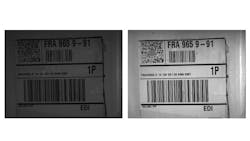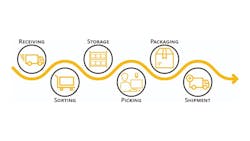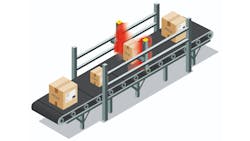Machine Vision Lighting Improves Logistics Warehouse Efficiency
Julia Kret, Product Manager, EFFILUX (www.effilux.com)
Machine vision plays an important role in improving traceability and efficiency in logistics operations by automating key inspection tasks as goods pass through the warehouse management process, from receipt to shipment. It can provide 100% inspection capabilities at high speed, and the large amount of data collected can be processed using specialized software to track the progress of items through the distribution center as well as interact with control systems for automatic routing of items to the correct places. Typical logistics inspection applications include:
- Barcode and data matrix reading
- Alphanumeric and lot code reading
- Verifying label presence before printing
- Dimensioning objects for storage, packing, and palletizing
- Robot vision for pick and place
- Tunnel scanning
As with all machine vision applications, lighting plays a prime role in delivering sufficient light to the scene, so the resulting images have the signal-to-noise ratio and contrast needed for accurate and repeatable measurements. The range of inspection applications requires a versatile approach to machine lighting solutions.
The need for dedicated machine vision lighting
Machine vision inspection can be deployed at multiple stages in the warehouse management cycle from receiving through sorting, storage, picking, packaging, palletizing, and shipment (Figure 1). Systems featuring integrated lighting can be well suited to applications where the target information, such as printed codes or labels, appears reliably within their field of view.
However, significant variation in the objects that pass through the inspection point, or a wide field of view require separate cameras and lighting solutions. In logistics applications, there are many types of variations. Packages can vary in size, shape, and materials (poly bags, boxes, pallets, etc.). Moreover, the printed code or label position can often be anywhere on the surface of the package. The package’s orientation is an additional factor that creates countless possible variations in logistics applications, which presents significant lighting challenges.
In addition to the variation challenge, logistics applications are also characterized by high speed. For a logistics warehouse to maintain efficiency, packages must move quickly down a conveyor to the appropriate location. The volume of packages that enter a warehouse daily also means that automated inspection points operate continuously for long hours. This places high demand on the lighting solution to provide sufficient brightness to capture a package moving at high speed and maintain that level of brightness throughout the day.
To accommodate these demands, a logistics application needs to:
- Strobe a high-power, high-uniformity lighting solution.
- Cover a wide field of view to image packages regardless of individual differences.
The following are common applications found in logistics applications where logistics lighting solutions help capture the needed image.
Code reading
Image-based code reading systems are used extensively on automated sorting lines throughout the warehouse management cycle. LED systems offer high read rates as well the ability to read codes even when degraded by damage, orientation, or distortion.
High-speed conveyor lines in logistics are essential to warehouse efficiency. Thus, camera exposure times must be very short to prevent any blurring in the image, and pixels exposed for a short time need high-intensity light (Figure 2). This is especially important when reading small codes on large boxes using MPixel resolution cameras. Applications where the code position varies also demand high uniformity so that regardless of the code’s placement, it is clearly readable on the surface of the package.
Light manufacturers focus mainly on the key parameter for code reading, which is having the highest power strobe. Lights also need to be ultra-fast to keep up with conveyor speeds. Logistics applications can require lights to pulse up to several hundred microseconds and 150Hz frequency with less than 1µs response time.
The variation in package size and code placement can also require a wide field of view, which demands a lighting solution large enough to illuminate the entire area. The field of view is not limited to one surface either. Since many packages have codes printed on more than one side of the box or package, tunnel scanners can be configured with an array of machine vision cameras and lighting systems mounted around a conveyor to read codes and other machine-readable text on one or even all six sides of a box, depending on the requirements.
Dimensioning
Dimensioning is an important tool in the logistics cycle, offering easy measurement of the size and shape of items and packages (Figure 3). Warehouses and distribution centers need to have accurate measurements for all their products and shipments to use storage space optimally in warehouses as well as for efficient picking and packing for individual packages, pallets, or vehicles for shipment to minimize shipping costs.
Good contrast differences between the object and the background across the entire field of view are essential for edge detection algorithms. Similar to code-reading applications, high-power uniform lighting is essential to capture the edges of a package for dimensioning applications, even when the object is in motion.
The size of packages in dimensioning can vary greatly. When designing a dimensioning application, it is important to consider the largest possible package that will pass through and choose the appropriate field of view and working distance to accommodate that size. The subsequent lighting solution needs to illuminate the field of view without losing the necessary intensity and uniformity, especially for larger areas and distances.
Pallet scanning
Pallet scanning is needed at the goods-in and shipment stages of the logistics process. Pallets arriving at a warehouse or distribution center are scanned to read the incoming identification labels before depalletizing. At the shipment stage, pallet scanning enables efficient building of pallets.
A large of field of view is the key characteristic of pallet scanning applications. Individual pallets are over 1 meter long. When stacked together with packages, a group of pallets can become an incredibly large inspection target. LED logistics bar lights are available up to 3 meters (Figure 4) to suit any pallet size with the brightness and uniformity necessary to illuminate the full length of the pallet.
Related
- Lighting for pharma and medical device inspection
- Designing for camera advances key for lighting and illumination suppliers
Optimal logistics lighting solutions
To meet the demands of logistics applications, flexible and versatile lighting solutions for warehouse and logistics applications provide the high power, uniformity, and speed needed to illuminate the many types of packages that can enter a logistics center or warehouse. Other features can further improve the effectiveness of an inspection, such as:
- Choice of wavelengths (red, blue, etc.) for contrast optimization.
- Polarizer options to eliminate unwanted reflections on shiny packages or plastic wrapping film.
- Industry-standard fittings and connectors for easy installation at different inspection sites.
- Scalability to meet changing requirements.
Lighting solutions in the marketplace exist that provide all of these elements in a single system with easy adaptability for specific application requirements. Eliminating the need to incorporate hardware from multiple manufacturers eases integration into warehouse master control systems and provides a quicker return on investment with increased efficiency and more accurate inspection results.




